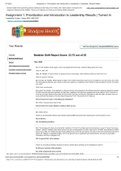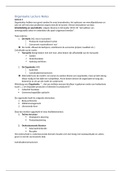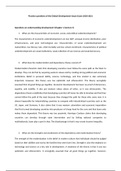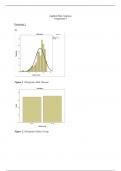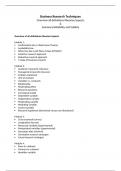0. Overview
1) List the key disciplines that contribute to the standard view of the cognitive sciences
• Psychology, Philosophy, Linguistic, Arti cial Intelligence, Neuroscience, Anthropology (6)
2) What is the Uncanny Valley?
It is a graph which displays that as robots become more
similar to ourselves, our feeling towards them change.
3) Where did Plato and Aristotle stand on the issue of the mind-body problem?
- Aristotle argues in line with the Monism or the Identity Theory according to which there is a single
material for both entities i.e. the mind is in the brain or body. This means is that all is physical. This is
also called materialism.
Plato believes that the mind and body have qualitatively di erent substrates. "Knowledge is
recognition?” This view ist called Dualism.
4) Describe the Classical Mind-Body Problem
- The Mind-Body Problem encompasses the question whether mind and brain have the same or
di erent material substances. According to Monism/Identitiy Theory, the mind and brain are the same
substance. This substance can be completely physical (materialism) or mental (idealism). Dualism
holds that they are qualitatively di erent substances.
5) What is “Occam’s razor?
- a scienti c principle Monism is simpler, there is only one set of terms.
1. Enhancement and Attention
Substraction Method - Donders (1895)
• 2 di erent tasks with the same stimulus /blue light) & same response (key press), di erence: RT
• detection = encoding + responding (350ms = average response time)
• task example: press key when blue light appears on screen
• discrimination = encoding + identifying + reaction selection + responding (500ms)
• task example: only respond (i.e. press key) to blue light, not yellow light
• model assumes discrete serial processing stages:
• assumption: mental processes such as sensory discrimination, perceptual identi cation, and motor
selection occur serially, each consuming a certain amount of time
• idea: if one could devise a pair of tasks di ering only in that one required an extra mental process, then
the di erence in reaction time (RT) to the two tasks would be an estimate of the duration of the extra
mental process
ff ff ff fi ff fi ff ff fi ff
, • method: The subtractive method measures the duration of mental processes by deleting a mental
operation entirely from the RT task. It uses the go-no-go task paradigm. Measure RT in two tasks that
di er in exactly one hypothesized processing step. The di erence is the length of that process. It thus
provides duration estimates for the stages.
mean RT Discrimination Task - RT Detection Task = RT mental discrimination of 2 stimuli
• Go-No-Go-Task:
2 stimuli are presented, respond only when one of them is shown —> encode + identify + respond
• Issue: How do I know that not other cognitive processes are active or in uencing?
• critical: it is assumed that a mental process can be added or omitted without in any way altering the speed
of the other processes. This is critical - for instance, changing a simple task to a more complicated one
changes the subject’s strategy, and the entire conscious information processing pattern is therefore
altered —> increasing a task’s complexity always a ects other stages, both qualitatively and quantitatively
• serial processing: processing of task in a sequential order
• parallel processing: simultaneous processing on several objects
Additive Factor Method (AFM) - Sternberg (1968)
• memory task: number sequence was presented - decide if number was in it
• = a method that uses reaction time measures over a range of tasks in order to identify di erent cognitive
processing stages
• model assumes discrete serial processing stages
• if two or more factors each in uence the durations of distinct stages, then the e ect of one the factors on
total duration will be invariant across the lives of the other factors —> the e ects of the variables on RT will
be additive
• —> presence or absence of interactions between variable is used to determine the processing stages
involves in task performance i.e. if variables interact they must in uence at least one common processing
stage
Bottleneck Theory
= we cannot consciously attend to all of our sensory input at the same time (Broadbent's, Treisman's models:
explain how material that passes though bottleneck is selected )
Broadbent's lter model of attention (1958)
= early selection theory of attention, at sensory level
• dichroic listening task to investigate the processes involved in switching attention which are presumed to be
going on internal in our heads: participant is instructed to attend (attended channel) the information coming
from one of the ear pieces and neglect (unattended channel) the information presented from the other
• Stages:
1. sensory memory store holds all information for a very short time
2. lters (bottleneck) according to physical characteristics, lter irrelevant stimuli
3. detector: processes info to determine higher-level characteristics of the message, such as its meaning.
fi ff fi fl ff fi ff fl fl ff ff ff
, 4. input gehts manipulated in short term-memory
Attenuation Model - Treisman (1960)
• model proposes that Information is attenuated di erentially for channels: lter determines how much
information from each channel is being processed
• selection occurs in two stages: an attenuator analyses the incoming message (accoding to physical
properties + meaning) and lets through the attended message at full strength - and also the unattended
message, but at a lower (attenuated) strength i.e. processing is limited in capacity .
• model allows for highly relevant information to be interpreted, even if the channel is not attended to
—> nal output of system is determined at the 2nd stage
Embodied Cognition Approach
= body contributes to the mind
• implementation matters for computation (Marr, 1982)
• debatable philosophical viewpoints:
• Extended Mind (Clark & Chalmers, 1998)
= external objects can be part of cognition
• example: Otto’s notebook is his extended mind
• O oading (Kirsh & Maglio, 1995)
• example: playing Tetris —> “o oading” the task to the computer: players actually rotate the objects, and
do not do this only in their head
• Radical Embodied Cognition (Chemero)
• perception —> action (nothing in-between, no representations)
Mental Representations: 3 Levels of Analysis
1. Computational: What is the problem to be solved? (i.e. input/output mapping of the mental process)
2. Algorithms: how is this calculation carried out?
3. Implementational: What is the hardware that makes the calculation possible?
The “Mark of the Cognitive” (Adams & Garrison, 2013/4, Minds & Machines)
di erent views:
1. having beliefs, desires, intentions is enough to have a cognitive process (—> reasoning)
2. behavior alone is no criterion, because bacteria and robots also move (i.e. show behavior)
3. Rowlands (2010): Process is cognitive if it…
… involves information processing
… makes information available
… produces a representational state
… belongs to the subject of the representational state
4. necessary vs. su cient conditions
5. enhancement through technology (Warwick)
e.g. external access with micro-chips
http://psy405.cankaya.edu.tr/uploads/ les/ch4(1).pdf
https://quizlet.com/69424457/attention- ash-cards/
Connectionism
= di erent view from AI besides serial processing
• cognitive states as distributed patterns of activation
• supervised (gives feedback if output is good) vs. unsupervised learning
ffl
ff fffi
ffi ffl fi fl ff fi

